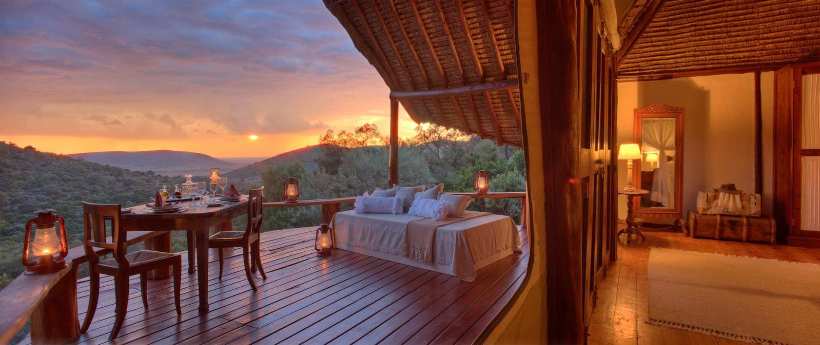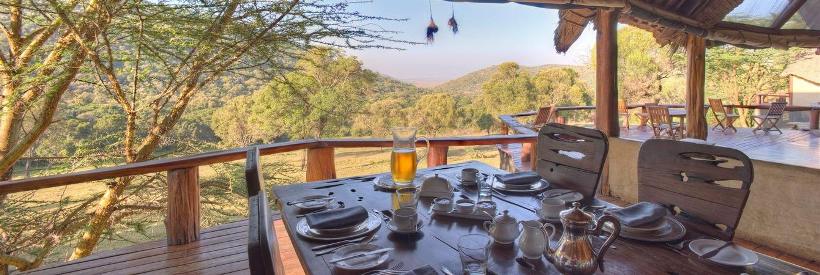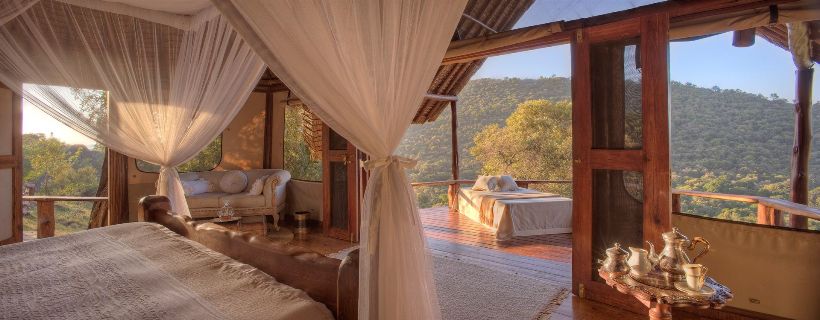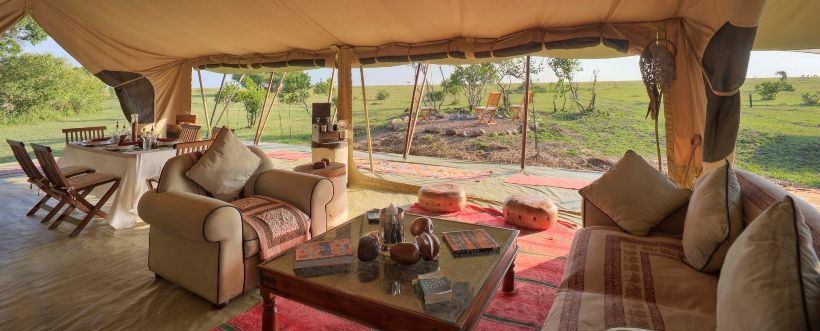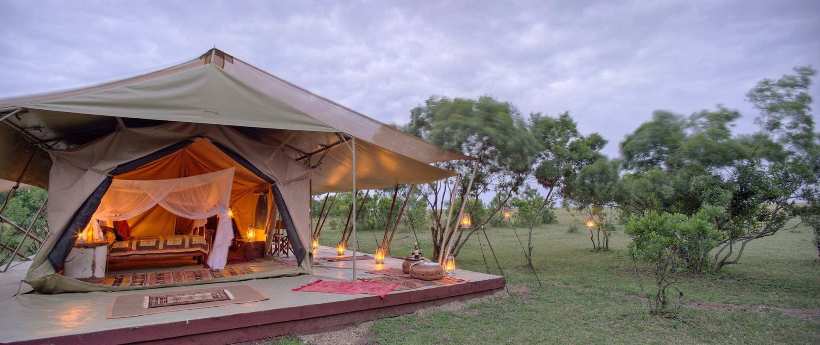www.African Safaris and Travel - Our safaris reflect every travelers style, time frame and budget!
Location:
Saruni is the deluxe, intimate lodge set in a private conservation area outside the Masai Mara National Reserve, the most famous game park in Africa. Established in 2003 by a group of friends who shared their passion for Africa (Riccardo Orizio, Pia-Sophie Wool, Paolo Barberis Canonico and Davide Barberis Canonico), Saruni accommodates 12 guests at the main lodge and six at our nearby tented camp, Campi ya Tembo.
Set in a remote valley at the heart of the most exciting wilderness of Kenya, the lodge offers a new concept of African safari: a real adventure lived in harmony with the Maasai warriors coupled with high standards of style and comfort.
The Masai Mara:
The Masai Mara National Reserve of Kenya covers 1,672 square kilometers (more than 400,000 acres) and is situated between 1,500 and 2,100 meters above sea level. It is part of the Serengeti ecosystem that extends from northern Tanzania into southern Kenya. Around the Masai Mara National Reserve there are several "group ranches" or ancestral wildlife areas owned collectively by the Masai communities. The Lemek-Koyiaki Group Ranch, in which Saruni is set, has an area of 1,490 square kilometers (368,000 acres) and its natural treasures are managed by the several trusts set up and managed by the Masai people. The Masai Mara region is considered the jewel of African wildlife and nowhere on the continent can you find the same abundance and variety of wild animals. It is also a prime area for ornithologists and hundreds of different bird species have been recorded. The area is teeming with herbivores that, in turn, support large numbers of predators. Millions of wildebeest, gazelle, zebra, buffalo, impala, topi, hartebeest, giraffe, eland, elephant, dik-dik, hippo and warthog live their natural lifecycle alongside the largest population of lions in Kenya as well as cheetah, leopard, hyena and jackal. The Mara is also one of the best wilderness areas in Africa to observe rare species, like the rhino, the bat-eared fox or the nocturnal wildlife, from the bushbaby to the genet.
The scenery ranges from the rolling hills dotted with acacias, made famous by endless wildlife documentaries, to the lesser known mountains, rivers and valleys where the vegetation can be very green and lush. The highlight of the Masai Mara is the famous annual migration of wildebeest that move north from the Serengeti in Tanzania each July-August in search of fresh grazing. After remaining here for three or four months they return south in October before the beginning of the rainy season. Watching millions of these animals traveling en mass is truly a humbling experience for human observers.
The Masai Mara is, above all, the home of the Maasai, a traditional semi-nomadic people known for their beauty, intelligence and a deep love and understanding of the African wilderness. After running the risk of developing too quickly, in recent years the Masai Mara has entered a period of renaissance with a more considerate form of low-impact and sustainable Tourism emerging. To live in this African bush is a privilege. Saruni, in the Aitong area of the Masai Mara ecosystem, offers you a chance to share it. Each day is a different adventure at our tented lodge, overlooking the plains but set in a shady valley where the animals wander in total freedom. In front of the main verandah elephants and bushbuck, baboons and impalas all come to drink at our waterhole.
Accommodation:
Designed and built by Kenyan architect Mark Glen, Saruni has six large cottages, where one can experience both the elegance and safety of a permanent accommodation with the thrill of sleeping in close contact with nature. The rooms are furnished with colonial antiques, Persian carpets and African art. The atmosphere at the camp is informal but elegant.
Each cottage has hot and cold running water, 220 volt electricity, elegant Italian bathroom fittings, polished wooden floors, and large bathrooms where the canvas front can be totally open to offer you an amazing "shower with a view". Décor is unique for each cottage and from the large verandahs one enjoys a unique view of the Mara plains and can watch the many wild animals that come to our waterhole. Your safari actually starts on our massive cedar beds, from where you can see in total privacy elephant, leopard, waterbuck, bushbuck and impala traversing freely and peacefully in the grounds of the camp.
Kuro House is the common dining area and is a mixture of old-fashioned Africa and modern design. Its huge fireplace is the focal point of life at Saruni and it is here that our guests exchange memories of the day's safaris. While reminiscing they can start to savor the exceptional cuisine that is served around our long table and uses fresh, locally grown and organic produce in inventive ways.
Alternatively meals can be taken in the bush among the wild animals, with birdsong and animal calls as a backdrop. By separate arrangement a candlelight dinner can be served on your own verandah. A unique feature of Saruni is its collection of books and its library, the most beautiful in the African bush. With thousands of rare books and its very private location, Saruni's library is a place where to meditate, to rest, to think. Saruni has a low impact on the environment thanks to the use of solar power and the recycling of waste.
Saruni Wild:
Saruni Wild is the private, 3-tents camp owned and managed by Saruni in the Masai Mara. Located in a wild, scenic valley rich both in wildlife and privacy, where no other vehicles are ever met, Saruni Wild is a design camp with oriental-looking tents and all the comforts: flush toilets, hot and cold water, large showers, excellent cuisine and open Land Rovers.
Elegantly styled, each tent has a large verandah with uninterrupted views over the Yaile mountains of Northern Masai Mara and a big bonfire where the Masai warriors come and dance at night.
Saruni Wild’s secret valley has a large resident population of elephant, giraffe, zebra, buffalo and impala. Ideal for walking, for birdwatching and for observing wild animals that are still not used to the human presence, the camp will provide our guests with a unique experience: the Masai Mara off the beaten tracks.
The location is a piece of pristine, old Africa, still totally untouched by modern development: thousands of acres where there are no roads, no villages, no humans. Wildlife is abundant, but not habituated to contact with vehicles. This is true Africa and we have trained our guides to the highest standard to provide a thrilling, adventurous but comfortable experience. You will track wild animals and learn bush skills. Walks are individually tailored and are set in a breathtaking valley, forests, springs and mountains.
Our tented camp is an ideal base for those who interested
in watching, tracking and studying elephants. An activity
offered at Saruni Wild is night game drives: all the
nocturnal species are abundant around the camp, from leopard
to greater galago, from genet to white tailed mongoose.
Weather conditions are ideal all year round: it’s never too
hot.
The Masai:
Although the 300,000 Masai are only about 2 per cent of the Kenyan population they are, by far, the best-known tribe. Beautiful, proud and colorfully dressed they are still very close to their traditional way of life. Always witty and genial the Masai are a Nilotic tribe of pastoralists who until very recently led a semi-nomadic life, which is exactly the opposite of the main Kenyan tribe, the Kikuyu.
The Masai arrived, in what is today Central Kenya, from the Sudan between 500 and 1,000 years ago. A fascinating hypothesis suggests that the Masai - warriors and soldiers by instinct - are the descendants of a lost Roman legion that either deserted or became lost in the southern fringes of the Roman Empire. A few details of their dress and habits support this theory. For example, the sword that every Masai man keeps to hand is identical to the daga of the Roman legionnaires as well as their shields and sandals. In addition, the red colours of the traditional Masai "shuka" is similar to what is believed to have been the uniform of the soldiers who were fighting for the Roman Empire.
Traditionally the Masai lived on a diet of blood and milk
and no household is without cattle as they are the "money"
and "bank accounts" of the Masai. For this reason cattle are
rarely killed and eaten as they represent the owner's
wealth. Goats and sheep are also important in the Masai life
and economy.
The Masai house is a "boma" which is often a circular group of small huts built of mud and cows' dung. Around the entire compound there is always an enclosure to protect the cows and goats from the unwanted attentions of predators during the night.
The Masai have been deliberately slow in catching up with the modern world. Their attitude is one of respectful lack of interest towards many of the "necessities" that we regard as essential to modern life, from formal education to technology, from transport to access to the media. Of course, things are changing, but the Masai are not too keen to join in the rush for globalization.
However it would be wrong to think of the Masai as simple
and noble "savages". Politics are a passion and also a duty
for every Masai man, who is not afraid to spend long hours
in sophisticated debates and meetings. The intricacies of
Masai hierarchy, rivalries and internal disputes are as
fascinating and as complex as the equivalent debates in
Moscow, Washington or London. Tough negotiators and fearless
fighters in real or metaphorical battle, the slim and
elegant Masai are much more than a walking picture. While on
safari with us, you will be able to meet the Masai warriors
and their families. Most of our employees are from the
surrounding areas and are very keen to introduce you to
their fascinating traditions. They will become your friends.
The Migration:
The Masai Mara and adjoining Loita Plains form the northernmost part of the 25,000km Serengeti-Mara ecosystem. The Mara receives the highest rainfall (1000mm average, 1200mm a year at Musiara) of the entire ecosystem. Rain falls here through the year, with peaks usually in December, January and April. Plenty of grass remains after the Serengeti plains to the South have dried up.
This beneficent ecosystem supports a wildebeest population of at least 600,000. Together with the associated herds of 200,000 zebra and 350,000 Thomson gazelle, they form a vast assemblage of ungulates whose annual movements trough the ecosystem is known as "The Migration". The sight of hundreds of thousands of these animals moving together through the seas of grass must rank as the greatest wildlife spectacle on earth.
The wildebeest herds congregate during the wettest part of the year in the short-grass plains of the Serengeti ecosystem, where there is sweet new grass and rainwater pools. There they give birth - most of the females calving within a few week in what has become known world over as "The Rut".
Early in the dry season, the pools in the short-grass plains dry up and the wildebeest stream en masse through the longer plains and on to the Western Corridor. As their food supply diminishes, the herds move into the northern Serengeti woodlands and the Masai Mara.
Zebra follow similar, but not quite identical, movements. Thomson's gazelle also migrate, but only as far as the edge of the woodlands. The routes taken by the herds vary from year to year but the general pattern of the migration remains the same.
Once in the woodlands the herds spread out but keep moving in response to rainfall and the availability of forage. The first wildebeest usually arrive in the Mara in June or July and most remain there until late October or early November. Slowly at first, but increasing momentum, the wildebeest leave the Mara by various routes as they follow the rains back south. The annual incursion of the great herds into the Mara is a comparatively recent phenomenon. Prior to 1969, a few wildebeest "spilled over" from the Serengeti in very dry years, but most of the wildebeest found in the Mara belonged to a completely separate population, the Loita population. The Loita wildebeest, commonly referred to as the "residents", perform seasonal movements between the Loita plains in the wet season and the Mara in the dry months.
Following the tremendous increase in the Serengeti herds in the 1960s and 70s, the Mara is now dry season refuge for up to 600,000 Serengeti wildebeest as well as about 25,000 Loita animals."
Accommodation Rates:- From
$500 per person per night sharing.
Please contact us
for a quote and suggested itinerary.
